Your FEI software license is protected by a license key. Each time the application is launched, it checks for a valid license key. If a valid license key is found, the application runs. Otherwise, you are requested to get a valid license key.
has separate license keys for all editions and extensions.
Node-locked licensing allows the software to run on a single, identified computer only.
If you have purchased floating licenses, one or several concurrent users can run sessions at the same time from their computers located on your local network. The number of concurrent users is given by the number of tokens purchased. In this case, you must install FlexNet Publisher license server manager on a local server. Then, on each end user's computer, you will need to specify the location of this local licensing server (see FNP license server mode).
 About menu). After this date, will stop working. This is usually the case for
trial licenses, Beta, or for renewable rented licenses (i.e., yearly subscriptions).
About menu). After this date, will stop working. This is usually the case for
trial licenses, Beta, or for renewable rented licenses (i.e., yearly subscriptions).

| Figure 2: License Manager - No Valid License Found |

| Figure 3: License Manager - Configuration Wizard |
Note: Other actions may be available depending on the configuration mode.
Activate a Node-Locked License
When you purchase one or more (editions and/or extensions) licenses, you should receive an email from fei@flexnetoperations.com containing a set
of activation codes for each purchased product or option.
The Activate button is enabled when the activation codes into the provided text field respect this format:
<EntitlementId> [<HostId>] <ProductName>_<ProductVersion> .
HostId is optional.
A connection to the online activation server will start immediately.
When activation is complete, the product is ready to be used and the license manager displays information related to the activation.
An activation code is a string similar to the following:
#License: ( - 1 year time-limited node-locked application license (including maintenance service) - Multiple platforms support) -
Expiration date: 12/13/2014:
BL5F-7773-A9F1-F79B _

| Figure 4: License Manager - Node-Locked Activation Wizard |
Add New Node-Locked License after Activation
Once is activated, you can add other node-locked license to activate new extensions or editions.
To do so:
 License Manager
License Manager
The Activate button is enabled when the activation codes into the provided text field respect this format:
<EntitlementId> [<HostId>] <ProductName>_<ProductVersion> .
HostId is optional.

| Figure 5: License Manager Dialog |
Transferring all Node-Locked Licenses to a New Computer
After activating a node-locked license on a computer, you may wish to move it to a new one. To do so, you first need to de-activate the first license by
returning the associated activation code and then activate it again on the new computer.
To do so:
 License Manager (see Figure 5)
License Manager (see Figure 5)
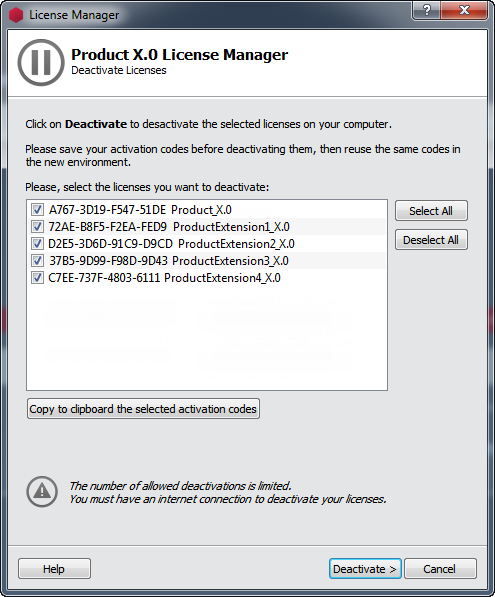
| Figure 6: License Manager - Deactivation Dialog |
Upgrading to a New Version
When a new version of is released, a dialog is displayed if the activation process was used for a previous version after installing and launching the new version. It offers several choices, including an Upgrade Local Licenses option (see Figure 7).
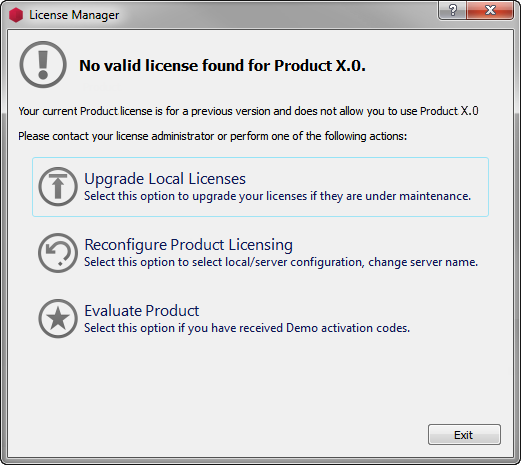
| Figure 7: License Manager - Upgrade Dialog |
If the licensed modules are under maintenance, they will be immediately available for use after the upgrade process.
Note: The previous version can still be used on the same computer even after upgrading to the new version.
Reactivating a License
When you use a renewable license (i.e., through a subscription agreement), will stop working when the license expiration date
is reached.
When you launch a new session of , an error dialog is displayed with several choices, including a Reactivate option.

| Figure 8: License Manager - Reactivation Dialog |
As soon as you have renewed your subscription, you can re-activate your node-locked license to allow to run again for a
new period of time.
Activate Demo licenses
The Demo licenses are node-locked and time-limited.
The Activate button is enabled when the format of activation code into the provided text field respect this format:
<EntitlementId> [<HostId>] <ProductName>_<ProductVersion> .
HostId is optional.
A connection to the online activation server will start immediately. When activation is complete, the product is ready to be used.

| Figure 9: License Manager - Demo Activation Wizard - Configure Demo Version Licensing |
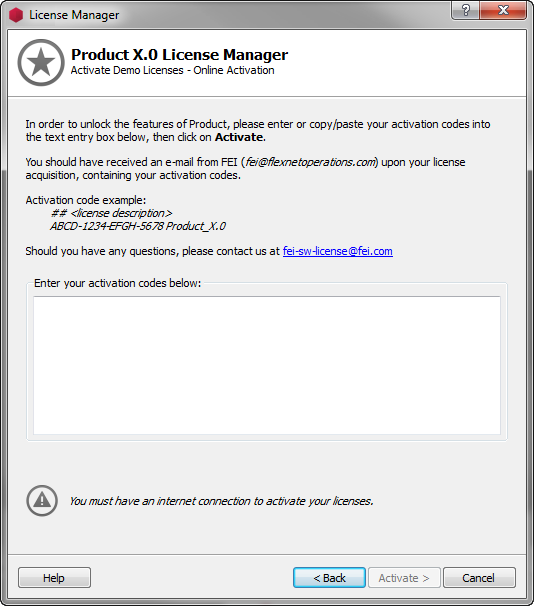
| Figure 10: License Manager - Demo Activation Wizard - Activate Demo Licenses |
Activate Beta Licenses
The Beta licenses are only node-locked and time-limited.
When you launch a Beta version for the first time, or if your Beta licenses are expired, the Activation Wizard is opened at the Configure Beta Version Licensing page.
The Activate button is enabled when the format of activation code into the provided text field respect this format:
<EntitlementId> [<HostId>] <ProductName>_<ProductVersion> .
HostId is optional.
A connection to the online activation server will start immediately. When finished, the product is ready to be used.

| Figure 11: License Manager - Beta Activation Wizard - Configure Beta Version Licensing |

| Figure 12: License Manager - Beta Activation Wizard - Activate Beta Licenses |
Activate a Node-Locked License
When you purchase one or more licenses (i.e., editions and/or extensions), you should receive an email from fei@flexnetoperations.com containing a set
of activation codes for each purchased product or option.
The Next button is enabled when the path of XML request file is specified. The format of activation code uses the following template:
<EntitlementId> [<HostId>] <ProductName>_<ProductVersion> .
HostId is optional.
The next page (see Figure 14) explains the remaining steps to perform before completing the offline activation request:

| Figure 13: License Manager - Offline Activation Wizard |

| Figure 14: License Manager - Offline Instructions |

| Figure 15: License Manager - Offline Import |
When activation is complete, the product is ready to be used and the license manager displays information related to the activation.
Add New Node-Locked License After Activation
Once is activated, you can add other node-locked license to activate new extensions or editions.
To do so:
 License Manager and click Activate Additional Extensions or Editions (see Figure 16).
License Manager and click Activate Additional Extensions or Editions (see Figure 16).
The Next button is enabled when the path of XML request file is specified. The format of activation code uses the following template:
<EntitlementId> [<HostId>] <ProductName>_<ProductVersion> .
HostId is optional.
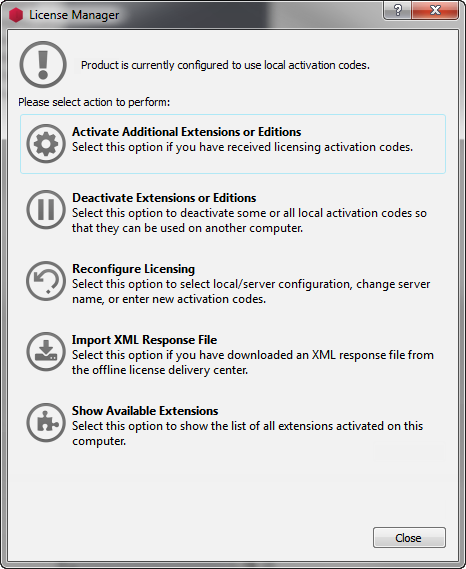
| Figure 16: License Manager Dialog Offline |
Transferring all Node-Locked Licenses to a New Computer
After activating a node-locked license on a computer, you may wish to move it to a new one. To do so, you first need to deactivate the first license by
returning the associated activation code and then activate it again on the new computer.
To do so:
 License Manager (see Figure 16)
License Manager (see Figure 16)
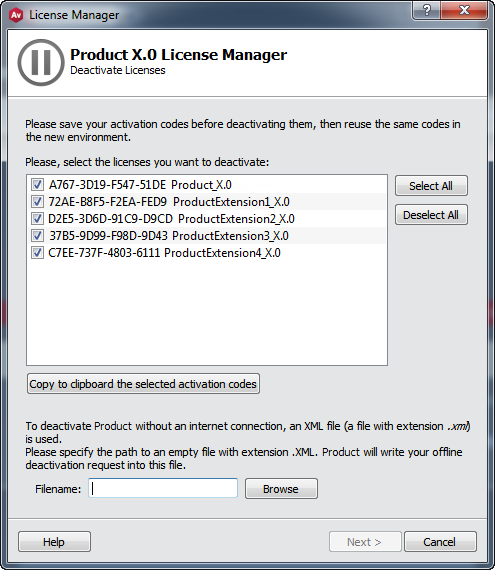
| Figure 17: License Manager - Deactivation Dialog Offline |
Upgrading to a New Version
When a new version of is released, a dialog is displayed if the activation process was used for a previous version after installing and launching the new version. It offers several choices, including an Upgrade Local Licenses option.

| Figure 18: License Manager - Upgrade Proposal Dialog Offline |
After clicking Upgrade Local Licenses, a dialog will open (see Figure 19), allowing you to select the licenses you want to upgrade and the path to the XML file that will contain your offline upgrade request. Click Next to display the offline instructions dialog (also listed in the "Offline Local Activation Mode" section). Once the import of the upgrade request has been performed (and if the licensed modules are under maintenance), the selected licenses will be upgraded and the new version of can be used immediately.

| Figure 19: License Manager - Upgrade Licenses Dialog Offline |
Note: The previous version can still be used on the same computer even after upgrading to the new version.
Reactivating a License
When you use a renewable license (i.e., through a subscription agreement), will stop working when the license expiration date is reached. When you launch a new session of , an error dialog will appear with several choices including a Reactivate Local Licenses option.
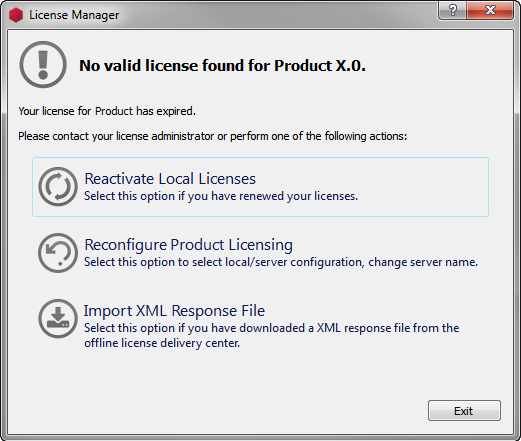
| Figure 20: License Manager - Reactivation Proposal Dialog Offline |
Click Reactivate Local Licenses to open the License Manager dialog box (see Figure 20) and select the licenses you want to activate plus the path to the XML file that will contain your offline reactivation request
(see Figure 21).
Click Next to display the offline instructions dialog (also listed in the "Offline Local Activation Mode" section).
Once the import of the reactivation request has been performed (and if you have renewed your subscription), the selected licenses will be reactivated and the new version of can be used immediately for a new period of time.

| Figure 21: License Manager - Reactivate Licenses Dialog Offline |
Activate Demo Licenses
The Demo Licenses are node-locked and time-limited.
The Next button is enabled when the path of XML request file is specified. The format of activation code uses the following template:
<EntitlementId> [<HostId>] <ProductName>_<ProductVersion> .
HostId is optional.
Once the import of the activation request has been performed, the product is ready to be used.

| Figure 22: License Manager - Demo Activation Wizard - Configure Demo Version Licensing Offline |

| Figure 23: License Manager - Demo Activation Wizard - Activate Demo Licenses Offline |
Activate Beta Licenses
The Beta licenses are only node-locked and time-limited.
When you launch a Beta version for the first time or if your Beta licenses are expired, the Activation Wizard will open on the Configure Beta Version Licensing page.
The Next button is enabled when the path of XML request file is specified. The format of activation code uses the following template:
<EntitlementId> [<HostId>] <ProductName>_<ProductVersion> .
HostId is optional.
Once the import of the activation request has been performed, the product is ready to be used.

| Figure 24: License Manager - Beta Activation Wizard - Configure Beta Version Licensing Offline |
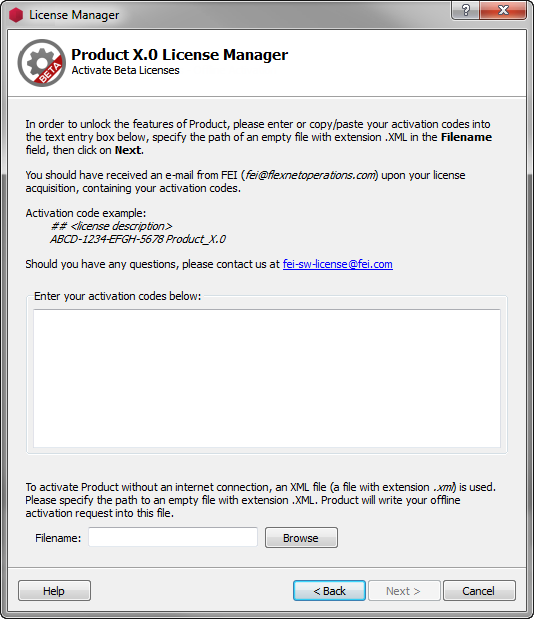
| Figure 25: License Manager - Beta Activation Wizard - Activate Beta Licenses Offline |
FNP License Server Manager Installation and Management
Refer to the following website to install a FlexNet license server and manage floating licenses,
including activation, upgrade, reactivation, and return:
http://www.fei-software-center.com/flexnet-server-doc/
Configure to Use Licenses from FNP License Server
At startup, select the Activate option and then Use FNP license server on the first page of the Activation Wizard.
You will need to specify the name of the FNP license server.
Optionally, you can specify a port number with a separator ":" (< ServerName> :< PortNumber>).
Using a specific port number depends on the way the server is configured.
In such a case, please contact your server license administrator for more information about the FNP license server configuration and the potential need to indicate a specific port number.
A connection to the FNP license server will start immediately. When done, the product is ready to be used.

| Figure 26: License Manager - FNP License Server Configuration |
Note: It is possible to test the connection to the specified server using the Test button.
You can change your configuration mode at any time, but this action requires that you restart the application.
To do so (in local activation mode), select Help  License Manager and click on the Reconfigure Licensing button.
License Manager and click on the Reconfigure Licensing button.

| Figure 27: License Manager - Reconfiguration Wizard |
Show Available Extensions
When is running, you can see the activated licenses on your computer.
Select Help  Show Available Extensions.
Show Available Extensions.

| Figure 28: License Manager - Available Extensions |
Note: One activation code can activate several licenses.
The log file is saved in the user application data directory:
This log file details all activation actions and licensing information only when an error occurs.
Below are instructions for setting this environment variable on
Note: For using a license debug filename as indicated below, you need sufficient privileges to write into the installation directory.
Otherwise, set VSG_LICENSE_DEBUG to a path where you can write files. For example, /home/<your_login_name>/debug.txt, or C:\Temp\debug.txt.
You can set the environment variable via the Control Panel for Windows or you can set it in a command prompt on all platforms.
Windows - Control Panel
Windows - Command Prompt
 Programs
Programs  Accessories
Accessories  Command Prompt
Command Prompt